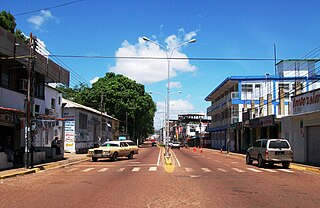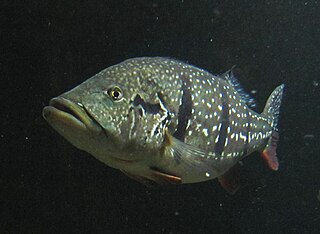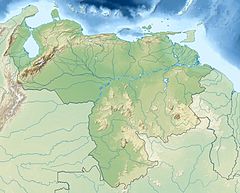
The Branco River is the principal affluent of the Rio Negro from the north.

The Casiquiare river or canal is a natural distributary of the upper Orinoco flowing southward into the Rio Negro, in Venezuela, South America. As such, it forms a unique natural canal between the Orinoco and Amazon river systems. It is the world's largest river of the kind that links two major river systems, a so-called bifurcation. The area forms a water divide, more dramatically at regional flood stage.

The Orinoco is one of the longest rivers in South America at 2,140 km (1,330 mi).

The Rio Negro, or Guainía as it is known in its upper part, is the largest left tributary of the Amazon River, the largest blackwater river in the world, and one of the world's ten largest rivers by average discharge. Despite its high flow, the Rio Negro has a low sediment load.

Pterophyllum altum, also referred to as the altum angelfish, deep angelfish, or Orinoco angelfish, occurs strictly in the Orinoco River Basin and the Upper Rio Negro watershed in Southern Venezuela, Southeastern Colombia and extreme Northern Brazil.

A blackwater river is a type of river with a slow-moving channel flowing through forested swamps or wetlands. Most major blackwater rivers are in the Amazon Basin and the Southern United States. The term is used in fluvial studies, geology, geography, ecology, and biology. Not all dark rivers are blackwater in that technical sense. Some rivers in temperate regions, which drain or flow through areas of dark black loam, are simply black due to the color of the soil; these rivers are black mud rivers. There are also black mud estuaries.

Puerto Ayacucho is the capital and largest city of Amazonas State in Venezuela. Puerto Ayacucho is located across the Orinoco River from the Colombian village of Casuarito.
The Ventuari River is the largest tributary of the Orinoco in southern Venezuela. The Ventuari flows from south-central Venezuela in the Guiana Highlands southwest into the Orinoco River. It is 520 km (320 mi) long and its major tributary is the Manapiare River.

Cichla temensis, the speckled peacock bass, painted pavon, royal pavon, speckled pavon, three-barred peacock bass, or striped tucunare, is a very large South American cichlid. Reaching nearly 1 m (3.3 ft) in length, it is the largest cichlid of the Americas, and one of the largest extant cichlids in the world. It is an important predator in its native waterways, as well as a prized food fish and game fish, which has led to a number of attempted introductions outside of its native range.
The Vaupés Arch is a hydrographic feature in the geology of Colombia. The Vaupés Arch forms the major drainage divide in the southern extent of the Llanos region of eastern Colombia and the western slopes of the Guiana Shield in Venezuela. The Vaupés Arch is the result of an episode of tectonic uplift that occurred approximately 8 to 10 Ma. The rise of the Vaupés Arch divided the basin of the Amazon from the headwaters of the Orinoco for the first time. Much of the Arch is now buried under thick sediments washed from the Andes. Shifting meanders of the area's numerous waterways have spread these sediments evenly over the flat alluvial plain, which has very little relief. In modern times the Casiquiare canal, to the south of the Arch, reconnects the two headwater basins, the Upper Orinoco and the Upper Rio Negro, a major Amazon tributary.

Village Creek is a blackwater tributary of the Neches River in Texas, United States. It arises in northwestern Hardin County outside the community of Village Mills. Due to the waterway's isolation and absence of impoundments, it is known to be pristine supporting cypress swamps and hardwood forests, as well as many rare and endangered species. It is 63 miles (101 km) long and average streamflow at the mouth is approximately 1,000 cubic feet per second (28 m3/s). It passes through three conservation areas on the way south, being: the Big Thicket National Preserve - Village Creek Corridor Unit, Roy E. Larsen Sandyland Sanctuary, and Village Creek State Park.

A whitewater river is classified based on its chemistry, sediments and water colour. Whitewater rivers have high levels of suspended sediments, giving the water a pH that is near-neutral, a high electric conductivity and a pale muddy, café au lait-like colour. Whitewater rivers are of great ecological importance and are important to local fisheries. The major seasonal Amazonian floodplains known as várzea receive their water from them.

The Negro–Branco moist forests (NT0143) is an ecoregion of tropical moist broadleaf forest to the east of the Andes in southern Venezuela, eastern Colombia and northern Brazil, in the Amazon biome. It lies on the watershed between the Orinoco and Rio Negro basins. It includes both blackwater and whitewater rivers, creating different types of seasonally flooded forest. The vegetation is more typical of the Guiana region than the Amazon.
Kirk O. Winemiller is an American ecologist, known for research on community ecology, life history theory, food webs, aquatic ecosystems, tropical ecology and fish biology. A strong interest of his has been convergent evolution and patterns, causes and consequences of biological diversity, particularly with respect to fishes. His research also has addressed the influence of hydrology on the ecological dynamics of fluvial ecosystems and applications of this knowledge for managing aquatic biodiversity and freshwater resources in the United States and other regions of the world. He currently is a University Distinguished Professor and Regents Professor at Texas A&M University and an Elected Fellow of the Ecological Society of America, American Fisheries Society and the American Association for the Advancement of Science.

A clearwater river is classified based on its chemistry, sediments and water colour. Clearwater rivers have a low conductivity, relatively low levels of dissolved solids, typically have a neutral to slightly acidic pH and are very clear with a greenish colour. Clearwater rivers often have fast-flowing sections.
Leporinus arimaspi is a species of anostomid fish. It is widely found throughout the Orinoco River drainage in Venezuela, including the tributaries Caura, Pamoni, Casiquiare, Manapiare, and Ventuari.
Pseudancistrus reus is a species of catfish in the family Loricariidae. It is native to South America, where it occurs in the Caroní River in Venezuela. It is typically found in presumably blackwater environments with low conductivity and a moderate current. The species reaches 7.7 cm SL. Its specific epithet, reus, is derived from Latin and translates to "prisoner", alluding to the species' barred patterning which resembles a stereotypical prison uniform.
Bryconops inpai is a small freshwater fish native to the rivers of South America. It only lives in two particular river systems - the Casiquiare and Negro - which means that its range is restricted to the northern half of the continent. It has indistinct humeral spots, and is bluish-silver in life, which is unusual for members of Bryconops; they are more often plain silver or greenish-silver.












